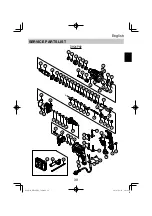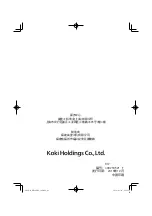
English
35
5. When driving wood screws (
Fig. 10 on page 34
)
(1) Selecting a suitable driver bit
Employ plus-head screws, if possible, since the driver bit easily slips o
ff
the heads of
minus-head screws.
Screw heads or bits will be damaged unless a bit appropriate for the screw diameter is
employed to drive in the screws.
(2) Driving in wood screws.
○
Prior to driving in wood screws, make pilot holes suitable for them in the wooden board.
Apply the bit to the screw head grooves and gently drive the screws into the holes.
○
After rotating the rotary hammer at low speed for a while until the wood screw is partly
driven into the wood, squeeze the trigger more strongly to obtain the optimum driving force.
CAUTION
Exercise care in preparing a pilot hole suitable for the wood screw taking the
hardness of the wood into consideration. Should the hole be excessively small or
shallow, requiring much power to drive the screw into it, the thread of the wood
screw may sometimes be damaged.
6. Hammering
only
This rotary hammer can be set to hammering only mode
by pressing the push button and turning the change lever
to the mark (
Fig. 11
).
(1) Mount the tool (bull point, cold chisel etc.)
(2) Press the push button and set the change lever to mark
between mark and mark (
Fig. 12
).
The rotation is released, turn and adjust the tool to desired
position (
Fig. 13
).
(3) Turn the change lever to mark (
Fig. 11
).
Then the tool is locked.
7. Using depth gauge (
Fig. 14
)
(1) Loosen the side handle, and insert the depth
gauge into the mounting hole on the side
handle.
Fig. 11
Change lever
Push button
Fig. 14
Side handle
Mounting
hole
Depth gauge
Fig. 13
Tool
Change lever Push button
Fig. 12
000Book̲DH24PH2̲ChS.indb 35
000Book̲DH24PH2̲ChS.indb 35
2019/02/12 10:18:10
2019/02/12 10:18:10














































